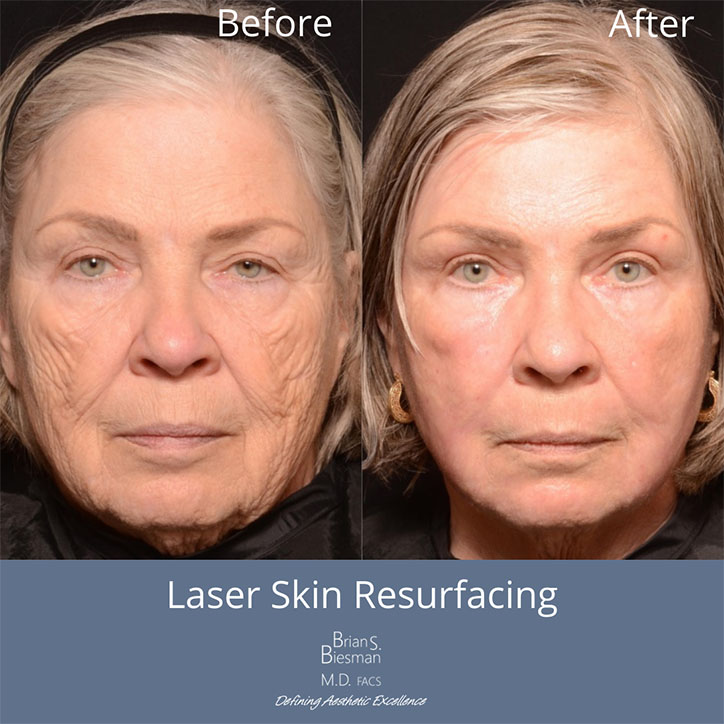A wide variety of lasers and related devices can help your skin look more youthful and fresh by correcting wrinkles, discoloration, scarring and many other skin conditions. Dr. Biesman, an award winning laser surgeon, can recommend an appropriate laser, light, or radio-frequency (RF) based skin treatment to help your skin look its best.
Learn about:
Laser Skin Treatment Methods
Laser skin resurfacing is the process by which a laser or similar device is used to deliver energy to the skin in a very controlled and specific manner. In response to this stimulus, the skin undergoes a healing process that results in elimination of discolored, sun-damaged areas, producing fresh, new skin. The regenerated skin is smoother in texture and appears more youthful and vibrant. There are many different types of skin resurfacing lasers allowing us to accomplish outcomes ranging from a light freshening of your skin with little to no downtime to correcting severe sun damage and deep wrinkling. The artistry of skin resurfacing lies in the user rather than the technology itself. Dr. Brian Biesman, an expert laser surgeon, will not only understand which device is likely to help you meet your needs but also is familiar with best practices in the use of that device to allow you to achieve your goals in the safest manner.
A Brief History of Laser Resurfacing
Laser skin resurfacing was first introduced in the early 1990s. The original procedure removed the entire outer layer of the skin’s surface, smoothed deep wrinkles, rejuvenated severely damaged skin, and helped smooth acne scars very effectively. While effective, this procedure required a lengthy recovery time.
New Fractional Laser Resurfacing Methods
Newer laser and energy-based technologies improve the appearance of sun damaged or scarred skin without the long recovery times associated with traditional laser skin resurfacing. The major difference between these technologies is the amount of controlled injury they produce. Some conditions require more aggressive treatment, while others can benefit from a lighter, less extensive treatment. One solution that shortens recovery time after laser resurfacing is to deliver energy in a grid-like pattern instead of treating the skin’s entire surface area. This approach is known as fractional resurfacing. As only a percentage of the skin’s surface is affected by each treatment, several fractional resurfacing sessions may be required to achieve best outcomes.
To help you understand which treatment might be best for you, here are a few things to consider:
- Superficial resurfacing treatments that only affect the top layer of the skin may help improve skin smoothness and brown discoloration, but will not reduce wrinkles.
- The recovery time after superficial treatments is shorter than after a deeper treatment.
- Deeper treatments are more likely to produce improvement in skin wrinkling and even induce skin tightening.
- Superficial treatments can often be performed using topical anesthetic creams, avoiding the need for injections.
- Deeper treatments are more uncomfortable and tend to require injections or other forms of anesthesia.
- Many different types of energy can be used to produce improvements in the appearance of your skin. The brand name of the device or the type of device used is less important than the knowledge and skill of the person determining which treatment is best for you.
- Treatment of scars is complicated and may require a combination of devices and medical treatment.
The following sections of this website will explore the various ways in which lasers and other state of the art technology-based devices can be used to help correct skin which has been damaged by aging, sun exposure, medical conditions, and accidents or injuries.
- Fraxel DUAL 1550/1927 nm
- Minimal Recovery Skin Rejuvenation
- Moderate to Aggressive Skin Resurfacing
- UltraClearTM Laser Resurfacing
